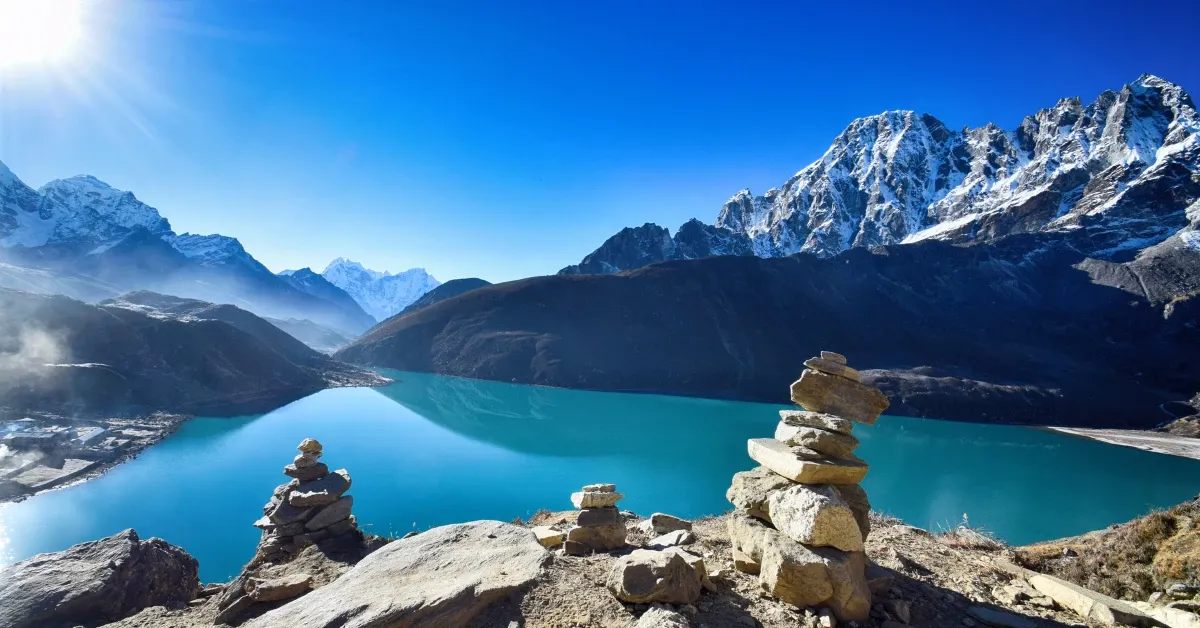Solukhmubu: Gokyo Lake Nepals' Himalayan Gem
Gokyo Lakes: Exploring Nepal's Himalayan Gem
 |
| View of Gokyo Lake| Photo from Canva |
Synopsis: Nestled in Nepal's Sagarmatha National Park, the Gokyo Lakes are the world's highest freshwater lake system, offering breathtaking views and a unique ecological habitat. Recognized as a Ramsar site, these lakes are of significant cultural importance to Hindu and Buddhist communities. Trekking to Gokyo Lakes presents an adventurous journey through rugged terrains, providing spectacular views of major Himalayan peaks and insight into Sherpa culture. The article emphasizes the need for responsible trekking practices and conservation efforts to preserve this natural wonder, ensuring it remains a pristine destination for future generations.
Introduction
Nestled in the heart of the Sagarmatha National Park in Nepal's Solukhumbu District, the Gokyo Lakes stand as a testament to nature's grandeur. This article delves into the breathtaking beauty, ecological significance, and cultural importance of this stunning lake system, the world's highest freshwater lakes situated at an awe-inspiring altitude of 4,700–5,000 meters above sea level.
The lakes derive their name from the towering Gokyo Ri peak, standing tall at 5,484 meters. Explore the etymology and significance behind this nomenclature, connecting the lakes to the lofty Himalayan landscape.
Discover the mesmerizing panorama offered by the Gokyo Lakes, boasting sparkling blue and green waters that mirror the sky and the surrounding mountain peaks. The article unfolds the picturesque allure that captivates both trekking enthusiasts and nature lovers alike.
Diversity in Sizes
Delve into the individual characteristics of each lake within the Gokyo system, with Gokyo Cho (Dudh Pokhari) reigning as the largest at 42.9 hectares. Explore the unique features of Thonak Cho, Gyazumpa Cho, Tanjung Cho, and Ngojumba Cho, each contributing to the overall magnificence.Uncover the sources feeding these pristine lakes, tracing the journey of glacial meltwater and streams from the Renjo La pass and the Ngozumpa glacier. Highlight the intricate discharge system via Taujon Lake and Longabanga Lake, emphasizing the hydrological importance of this high-altitude ecosystem.
Wetland Ecosystem Designation
The Gokyo Lake system achieved Ramsar site status in 2007, underscoring its significance as a crucial wetland ecosystem. Explore the implications of this designation and its impact on conservation efforts, covering the vast 196.2-hectare area.Cultural and Religious Significance
Unveil the cultural and religious significance attached to the Gokyo Lakes. Both Hindu and Buddhist communities hold the lakes in reverence, with the landscape resembling the moon's ethereal beauty, casting a shimmering white and blue glow.Trekking to Gokyo Lakes: A Himalayan Adventure
Embark on the adventurous journey to Gokyo Lakes through a rugged and challenging trail. The article narrates the trek starting in Lukla, mirroring the famed Everest Base Camp route until Namche Bazaar, where the trail diverges toward the Gokyo Valley.Experience the thrill of trekking amidst the towering peaks of Mount Everest, Lhotse, Makalu, and Cho Oyu. The journey unfolds breathtaking vistas and takes trekkers through remote Sherpa villages, providing insights into the local culture and lifestyle.
Highlight the physical demands of the Gokyo Lakes trek, emphasizing the need for trekkers to be in prime physical condition. Discuss the challenging terrain and the necessity for gradual acclimatization to the high altitude.
Guide prospective trekkers on the essential gear and equipment required for a safe and comfortable journey. From warm clothing to sturdy trekking boots and quality sleeping bags, this section ensures thorough preparation.
Optimal Times to Visit
Advise on the best times to visit Gokyo Lakes, targeting the autumn months of September to November and the spring months of March to May. Delve into the weather conditions during these periods, ensuring trekkers can maximize their experience.Caution against the winter months (December to February) due to extreme cold and snow-covered trails, making trekking challenging. Similarly, highlight the monsoon season in June to August, characterized by heavy rainfall.
Immerse yourself in the unique culture of the Sherpa people as the trek winds through remote villages. This section unravels the rich tapestry of daily life, traditions, and warm hospitality that trekkers encounter along the trail.
Cultural Festivals and Celebrations
Learn about the vibrant festivals celebrated by the Sherpa community. From Mani Rimdu to Dumji, discover how these festivals add a cultural dimension to the trek, providing trekkers with a glimpse into the spiritual and celebratory aspects of Sherpa life.Preserving the Gokyo Ecosystem
Delve into the ongoing conservation efforts aimed at preserving the delicate Gokyo ecosystem. Explore initiatives taken by local communities, government bodies, and international organizations to ensure the sustainability of this pristine natural wonder.Trekkers with knowledge about responsible trekking practices. This section emphasizes the Leave No Trace principles, waste disposal, and respecting the local environment, contributing to the long-term preservation of the Gokyo Lakes and its surroundings.
In Conclusion
In conclusion, the Gokyo Lakes stand as a Himalayan gem, weaving together natural beauty, ecological importance, and cultural significance. Whether you seek an adrenaline-pumping trek or a serene communion with nature, Gokyo Lakes offers an unparalleled experience.Frequently Asked Questions (FAQs)
Q: Is the Gokyo Lakes trek suitable for beginners?A: The Gokyo Lakes trek is challenging and recommended for experienced trekkers due to its rugged terrain and high altitude.
Q: What permits are required for the trek?
A: Trekkers need permits from the Sagarmatha National Park and a local government permit, obtainable in Lukla.
Q: How do I prepare for high altitude trekking?
A: Gradual acclimatization, physical fitness, and proper hydration are crucial for preparing for high-altitude trekking.
Q: Are guided tours available for the Gokyo Lakes trek?
A: Yes, numerous trekking agencies offer guided tours, providing experienced guides and logistical support.
Q: Can I camp near the Gokyo Lakes?
A: Camping is allowed in designated areas, offering a unique opportunity to immerse yourself in the pristine surroundings.
A Custom Message for Adventure Seekers
Are you ready to embark on the journey of a lifetime? Explore the wonders of Gokyo Lakes, where nature's beauty meets cultural richness. Uncover the secrets of the Himalayas and make memories that will last a lifetime.



